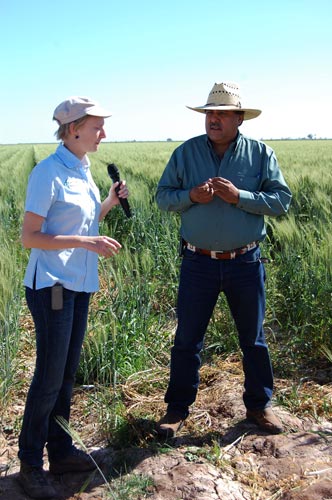Days #2 and 3 of CIMMYT Visitors Week, Ciudad Obregon, Sonora, Mexico
Many people perceive that wheat is a food eaten only by the rich; but they are wrong, argues Hans Braun, Head of CIMMYT’s Global Wheat Program. Addressing the group of scientists, farmers, politicians, and policymakers, in the INIFAP auditorium at CENEB, Ciudad Obregon, Braun presented some dramatic figures, illustrating just how many of the world’s poor are dependent on this staple crop.
Wheat is the main staple for approximately 1.2 billion poor people (living on less than 2 USD per day); providing 20% of the daily calories and 20% of the protein for people in the least developed countries. Rural migration in sub-Saharan Africa is causing the demand for wheat to increase faster than any other commodity – it is the basis of many of the ‘fast foods’ preferred by men who have left their families behind to earn money in the city.

Perhaps what is most concerning are the predictions for the near future. South Asia, where wheat is the second most important crop after rice, and where 74% of people live in poverty, will soon be home to 25% of the world’s population. If you look at a map showing the sites of recent food riots, it is almost identical to a map that shows countries where wheat provides more than one third of a person’s daily calories. The extreme heat wave and subsequent fires that led Russia to close it’s borders to wheat exports caused a dramatic rise in food prices and sparked riots across the region. “If food prices rise, governments fall,” stated Braun, and with climate change predicted to cause more extreme weather events such as those seen in Russia, CIMMYT’s wheat program is working to develop new varieties of drought-, heat-, and pathogen-resistant wheat.
On Day Two of Visitors Week, we visited Roberto Encinas, who is not a rich man at all. He farms 12 hectares of wheat just outside of Ciudad Obregon, 2 of which are now farmed under conservation agriculture (CA) practices. In fact, one of the reasons Encinas started to adopt CA was to reduce his costs, and so far he estimates that his CA crop has cost 200 USD less per hectare. Not only that, his crop his healthier. “I could see a difference right from the start,” says Encinas, “the CA crop is greener and has developed more slowly.” His technician says that whereas the conventional crop will probably produce 5tons/ha, the CA crop should produce 7tons/ha. “I am very convinced that CA is working and I will extend next year,” stated Encinas. Together with his farmer group, next year they hope to plant 50% of their 200ha total land under CA, with the support and guidance of CIMMYT-trained technicians.
 Capacity development
Capacity development